A Friday morning in July, the temperature is 30 degrees Celsius in the Capoto/Jarina Indigenous Territory, in northern Mato Grosso, in the Brazilian Amazon. Cacique Raoni Metuktire is standing on a stage that is assembled under a large tent of white tarp covering metal poles placed in the center of Piaraçu Village. In the audience, Kayapó (also known as Mebêngôkre) women and men stand. Gathered in small groups, they sing; the women on one side, the men on the other. They dance and celebrate. Joenia Wapichana, the president of FUNAI, Brazil’s Indigenous affairs agency, had given Raoni a framed map. He holds the gift over his head, showing it off like a trophy, perhaps the most important one he has achieved in his sixty years of fighting to defend the rights and territories of Brazil’s Indigenous people.
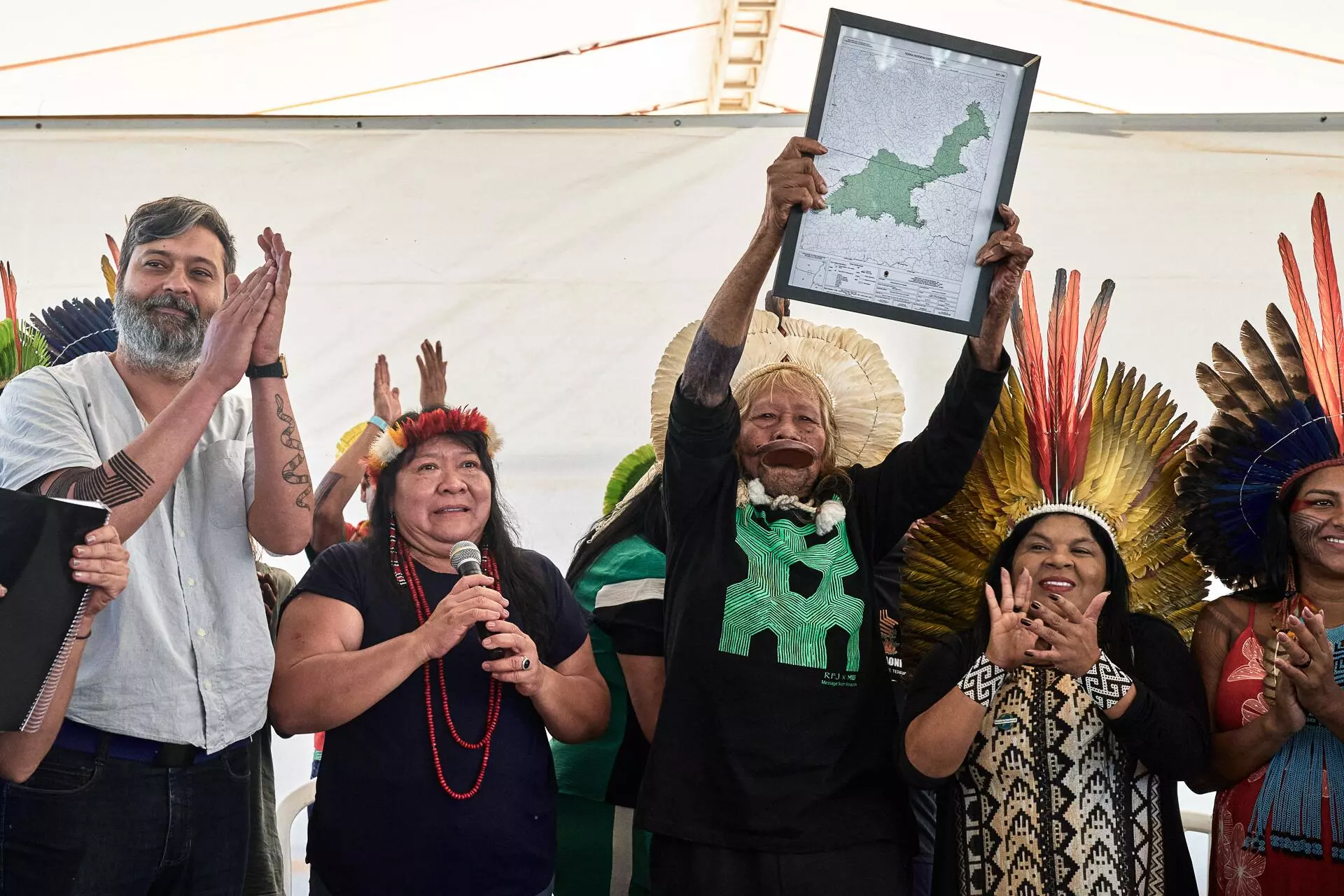
The head of Brazil’s Indigenous affairs agency, Joenia Wapichana, brought a gift for Raoni: the first step in the demarcation of the Kapôt Nhinore Indigenous Territory (on the map he is holding), a sacred territory for Raoni, has been finalized by the agency
The news Joenia brought was the culmination of the Call of Cacique Raoni, a five-day meeting of “Mother Earth Guardian Leaders” organized by the institute named for the man who is the biggest touchstone for original peoples in Brazil. On the last day, Joenia announced that FUNAI had recognized studies identifying and delimiting the area of the Kapôt Nhinore Indigenous Territory. “It’s the first big step for demarcation. It’s a gift that we came to bring to Raoni,” she proclaimed.
Raoni’s call brought representatives of fifty-four of Brazil’s original peoples to the village, along with non-Indigenous guests from Brazil and other countries. According to the organizers, 900 people attended the elder’s call to meet. Non-Indigenous people applauded, took pictures, and shot films with their cell phones. The tone was festive, to celebrate Raoni’s decades of fighting, but the cacique was also tough on his relatives: he warned them that Indigenous people who allow illegal mining and timber exploration in their territories must abandon this path. And, without bidding goodbye, he passed along important messages about his succession as the head of the Mebêngôkre.
Wedged between other Mebêngôkre territories whose boundaries have already been demarcated, amidst farms and areas of illegal garimpo mining, at the border between Mato Grosso and Pará, Kapôt Nhinore is a sacred place for Raoni. He was born there – and it is also where his father, Umoro, a medicine man, is buried. The area bears the mark of countless conflicts between Indigenous peoples and farmers. For Raoni, demarcating the Kapôt Nhinore territory was a question of honor and survival for his people.
You don’t have to understand the Mebêngôkre language to notice Raoni’s skill and eloquence as a speaker, a highly valued quality in the Kayapó culture. The adornment he wears on his lower lip, a labret, was placed there when he was 15, with the help of his brother Motibau. For the Mebêngôkre, the labret is “a mark of recognition of the warriors who are ready to die for their land.” Nothing defines the cacique better.
Raoni adjusts his tone, takes calculated pauses, and then resumes his speech, pointing and mentioning people he sees before him, in the audience. He then pulls out a map of his territory from behind his chair. At this moment, his grandson, Patxon Metuktire, begins translating his words into Portuguese – up to that point, only the speakers of the Mebêngôkre language had been following the speech. Raoni points to the map on the ground in front of him and, turning to the head of the Ministry of Indigenous Peoples, Sonia Guajajara, he announces: “I want to expand our territory on this line,” while he points to an area on the border between the Capoto/Jarina Indigenous Territory to the south and the Kapôt Nhinore Indigenous Territory to the north.
For decades, Raoni has done what he does over and over. He does not settle for a win – he continues to fight to demarcate his peoples’ traditional territories. With the support of his friend, explorer Cláudio Villas-Bôas (1916-1998), Raoni understood that the effort to conserve traditional territories is a cause common to all Indigenous people. This garnered him the admiration of leaders from over 300 groups of original peoples in Brazil. Along the way, he explained to non-Indigenous people why only a standing forest ensures human and non-human existence – and today, it is crucial to the planet’s survival.
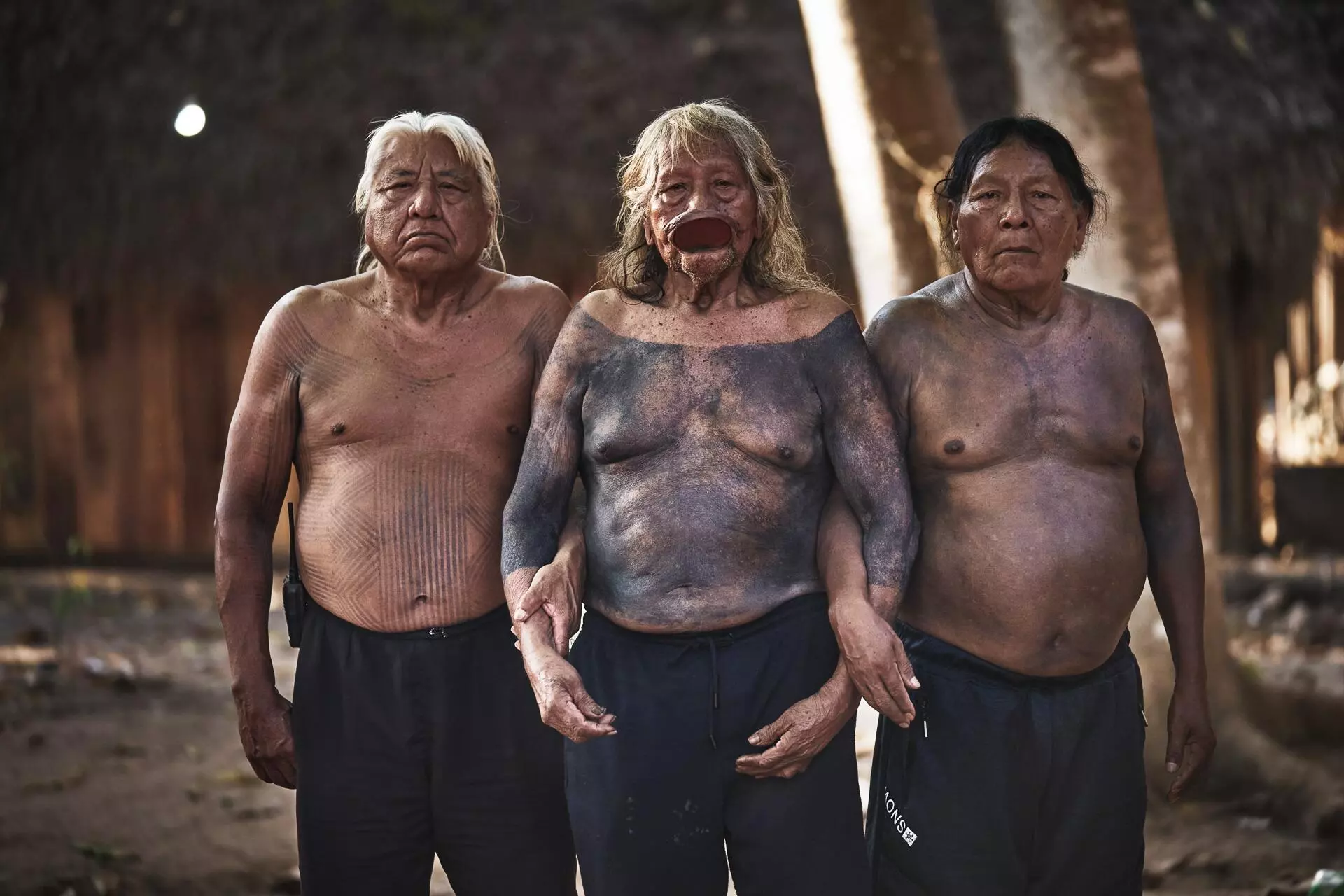
Raoni Metuktire stands between Megaron Txucarramãe (at the left of the photo) and Yabuti Metuktire (at right): both were announced as likely successors of the Kayapó cacique
In 2023, at an estimated 90 years old, Raoni is still concerned about the future. “We need to expand our territory. We’re going to draw up a document to send President Lula about this. The Indigenous population is growing here on the Xingu too,” he said. The last census, released in July by the Brazilian Institute of Geography and Statistics (IBGE), showed that there are 1.7 million Indigenous people in Brazil, 90% more than in the 2010 census. In the Capoto/Jarina demarcated territories, the population grew by 16%. “When we need to create more villages, there won’t be enough space,” the Kayapó leader warned.
Raoni knows he won’t be able to lead this fight for much longer. “You need to prepare. After I’m gone, the caciques of this generation, the future generation, will need to be very united and thoroughly prepared to defend the territories and peoples,” he tells the young people, according to Patxon’s translation. “I was very strong, I could walk fast. But now, I’m weaker and weaker, you all see it. I’m very tired.”
‘The sky fell, the earth caught fire’
Piaraçu Village is arranged in a circle, as is the custom in Kayapó culture. Along the outer perimeter are the homes – a few, like the school, are made of brick and mortar; most have wooden walls covered with straw. They surround a patio at the center of which lies the “House of Men,” a space for the village leaders to call gatherings and hold meetings. Because of the number of people attending Raoni’s call, the event’s main tent was assembled next to this structure. Temporary hammock areas, showers, and portable toilets were set up in the village and in neighboring communities. But attendance exceeded expectations and there was insufficient space for so many hammocks. Tents were improvised, water ran out. Everyone wanted to hear Raoni. And Raoni had plenty to say.
Sitting outside of a simple wooden home, Raoni spoke with SUMAÚMA at length on the muggy afternoon of July 28. “I wanted to bring together the leaders of peoples messing with illegal activities, with exploration of native wood, illegal mining, to encourage them not to continue along this path,” the cacique explained in an exclusive interview, according to a translation provided by another grandson, Beptuk Metuktire.
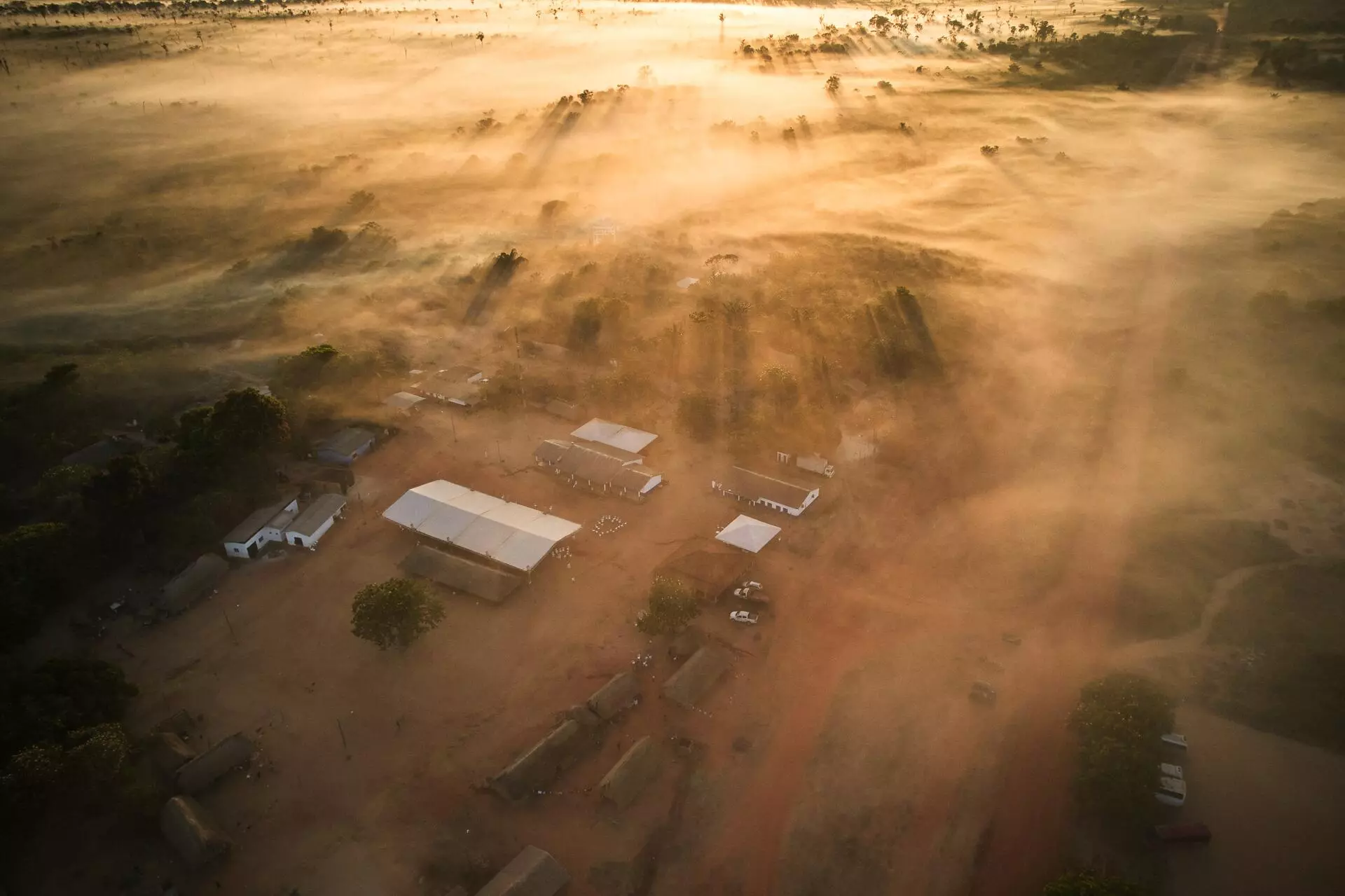
Piaraçu Village, Mato Grosso, Brazil: Indigenous territory was divided by the MT-322 highways during the business-military dictatorship
It’s a message that Raoni had already delivered the day before, on July 27, the day when the event opened to non-Indigenous attendees. That afternoon, he arrived at the main tent at around 4:00 PM. In high spirits, he greeted friends before sitting in the audience to watch the end of a debate whose members included Indigenous expert Sydney Possuelo, a former FUNAI president; Raoni’s nephew, Megaron Txucarramãe; the cacique of the Piaraçu Village; and Renan Sotto Mayor, a federal public defender who works with Indigenous communities. Raoni then took the stage, gripping the microphone and, speaking the entire time in his own language, went straight to the point: “I don’t want the Kayapó, the relatives present here, to lie to me, saying that they are defending the forest, their lands, yet they are continuing to do things that are wrong,” he said, according to the translation by his grandson Patxon.
“I would so like to go back to being young again, to defend the entire Indigenous population. I hope that this fight does not stop with you, the young people. My grandsons, do you hear me?” he asked. He next recalled how during the covid-19 pandemic, when he was sick, he dreamed that he had died – Kayapó women immediately stood from their chairs and began to sing. “But the father is in heaven, the mother is in the earth. These two people gave me strength, asked me to get up and stay strong in the fight. These spirits accompanied me, they are with me today. And, in the dream, they told me that the Earth has been extinct before. The sky fell, the earth caught fire. It was no more. If we do not defend what we have, it will happen again,” Raoni warned.
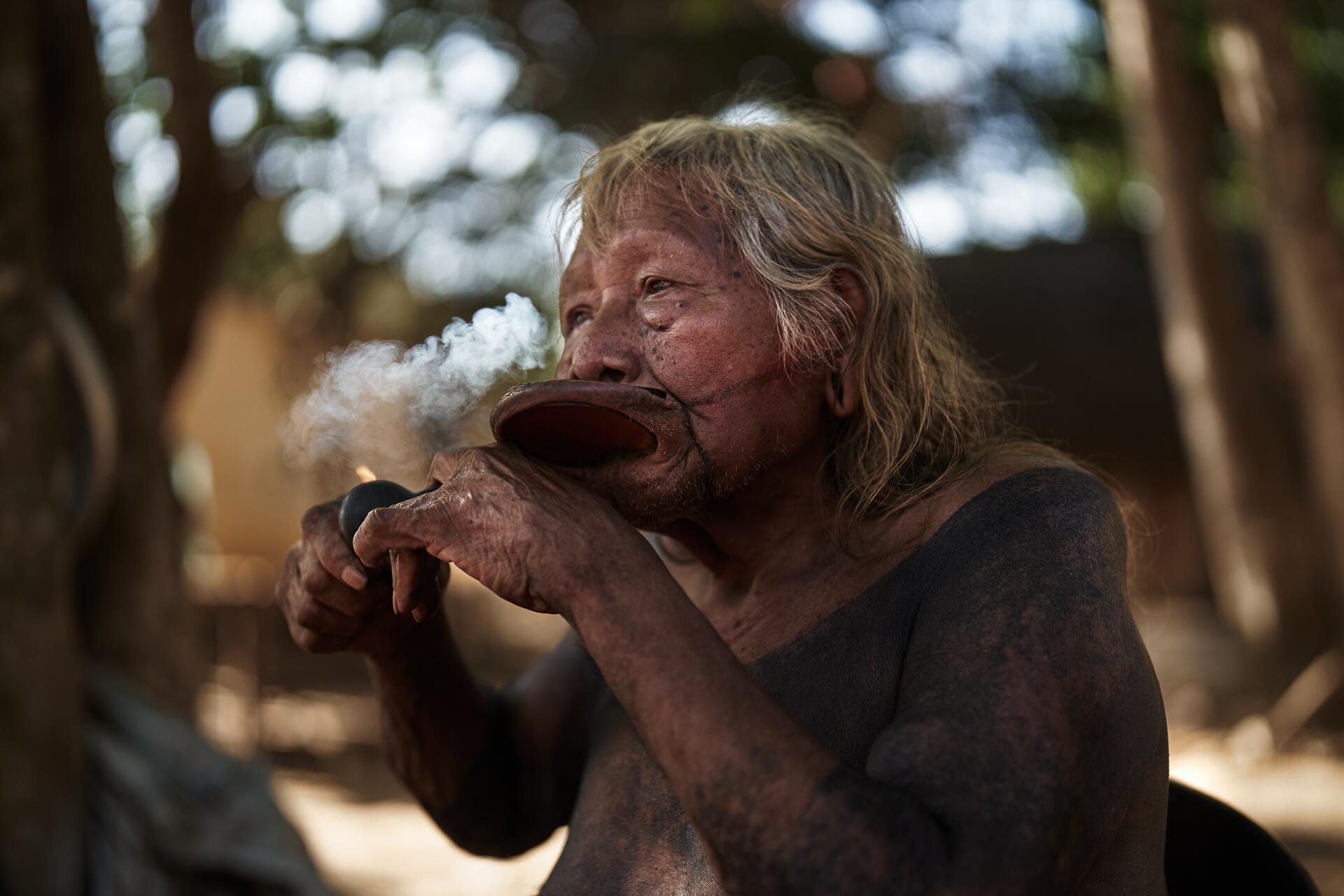
Raoni’s ever-present firmness and strength: the cacique warned relatives that they cannot collude with illegal mining, and he attempted a farewell, even though he continues to fight
Raoni knows what he is facing within Indigenous territories. And it’s nothing new. In the 1980s, Cacique Tutu Pombo made millions from mahogany exploration and by charging a percentage on gold mined from illegal mines on Kayapó Indigenous Territory, in Pará. He accumulated money and prestige until his death, in 1992. Decades later, in June 2023, João Kayapó, Tutu Pombo’s grandson, is now the cacique of Turedjam, one of the villages that continues to allow illegal mining operations. After years of exploration, João Kayapó says he wants to fight to prohibit this activity and expel the miners.
Raoni’s influence has blunted the force with which exploration has hit Kayapó territories further to the south, in Mato Grosso. Yet the money is tempting and, without the resistance of a leader of Raoni’s dimension, exploration could end up happening, as Indigenous leaders admitted to SUMAÚMA in a conversation in Piaraçu. “Another Raoni won’t be born. This is very worrisome,” said Yanomami leader Davi Kopenawa. “He’s been through so much – persecution, illness, losses in his family – and he keeps resisting. His territory is already demarcated, yet he continues to advocate for the demarcation of other peoples’ territories. It’s not everyone that has this,” says another leader, Alessandra Korap Munduruku.
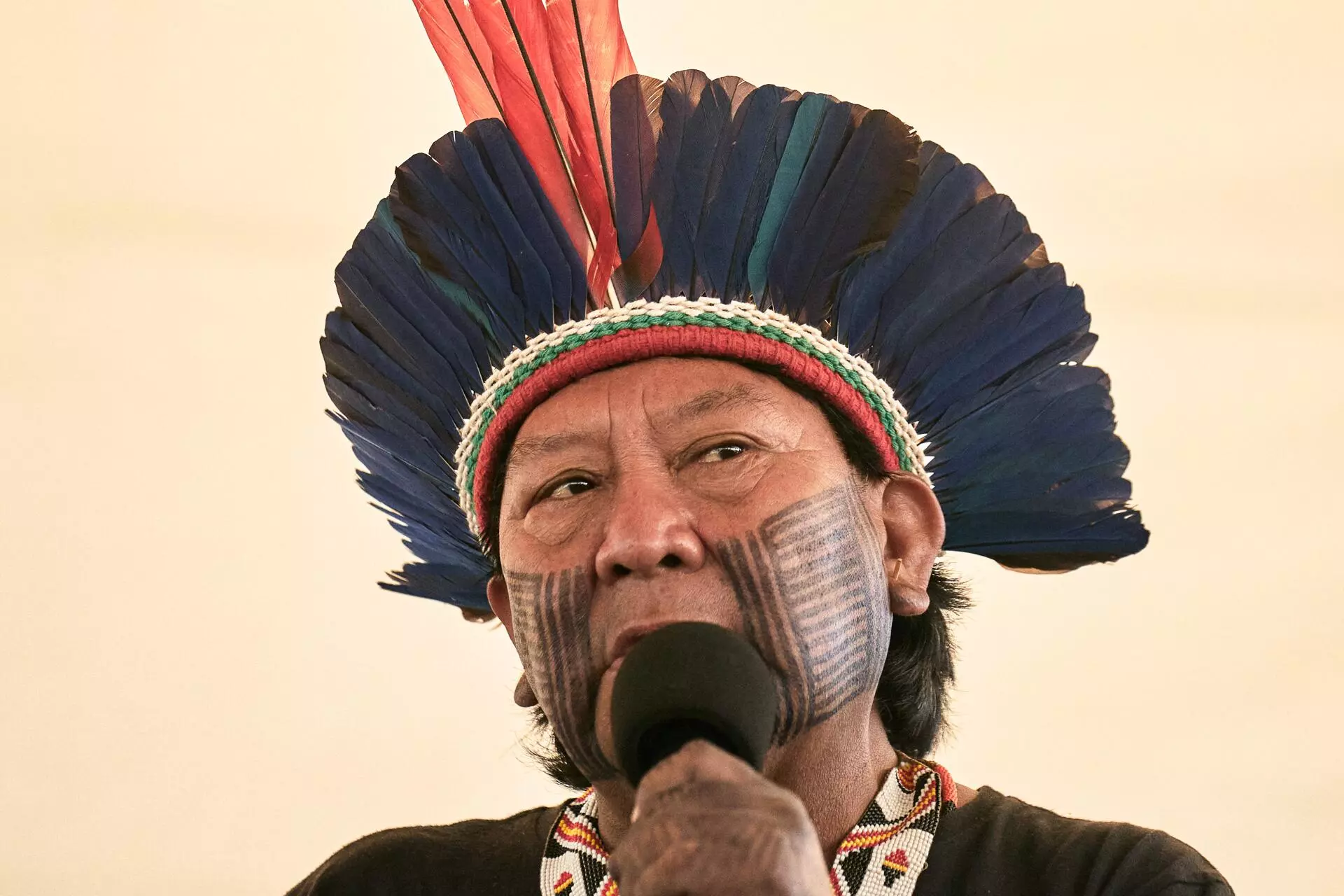
“Another Raoni won’t be born. This is very worrisome,” said Yanomami leader Davi Kopenawa
“Today I heard Raoni say that he was tired. In all these years, in so many meetings, for the first time I sensed his concern with the succession, with the continuity of the fight,” said Cacique Juma Xipaia. The first woman to lead Xipaya Village, on the Middle Xingu River, Juma is currently the secretary of Articulation and Promotion of Indigenous Rights under the ministry led by Sonia Guajajara. “Raoni publicly saying that he is tired, saying such strong things to the Indigenous youth, to Indigenous women, it was like feeling his embrace. But I don’t want to understand this as a goodbye, I don’t want to believe it,” she said. Raoni lent decisive support to Juma when she was threatened by grileiros – public land thieves – at the Amazônia Centro do Mundo meeting, held in Altamira in November 2019.

JUMA XIPAIA, THE FIRST INDIGENOUS WOMAN TO LEAD HER PEOPLE, IN THE MIDDLE XINGU RIVER AREA, SAYS SHE PREFERS NOT TO BELIEVE THAT RAONI IS SAYING GOODBYE
Preparing for succession without saying goodbye
During the afternoon, the day before, on July 27, at the speech where he asked his “grandchildren” for their attention, Raoni had said by the end of the event he would introduce “the leaders who will continue my work.” He never ended up doing this. The next day, when he was asked about his succession while speaking with SUMAÚMA, Raoni asked to call his nephew, Megaron Txucarramãe, 68, a Piaraçu cacique and a companion in many of his struggles over recent decades, and for Yabuti Metuktire, who is around 70 years old and is seen as Raoni’s likely successor as cacique of Metuktire Village, where both live.
Megaron is a figure that those fighting for Brazil’s Indigenous people recognize. He led the “ferry war,” in 1984, with Raoni before becoming the first non-white administrator of the Xingu Indigenous Park. In 2006, he helped with searches for the wreckage of a Gol Airlines Boeing 737 that had crashed in Kayapó territory after hitting a Legacy jet flying at an irregular altitude.
Yabuti’s Kayapó relatives and those working with them see him as one of the peoples’ last traditional caciques – he has a profound knowledge of Mebêngôkre cosmology and cultural traditions. A retired FUNAI employee, Yabuti still works at the Indigenous affairs agency, in a coordination office in Mato Grosso. In recent years, Raoni has begun to bring him along on his trips around Brazil and the world, repeating what he has already done for decades with Megaron.
People close to Raoni see a clear division of roles in the likely choice of these two: Megaron, the political leader, experienced in dealing with governments and non-Indigenous people; Yabuti, a traditional leader and guardian of the Kayapó culture. Although younger than Raoni, Megaron and Yabuti are already senior citizens. And a new generation of leaders is emerging in the Capoto/Jarina Indigenous Territory. It includes women like Mayalu Waura Txucarramãe, Megaron’s daughter, Kokonã Metuktire, Raoni’s daughter and the vice president of the institute that bears his name, and his nieces Nhakmeti and Yapi, as well as his grandsons Patxon and Beptuk. All that is left to know is if the influence they have on the Kayapó – with 10,0000 members and various subgroups, as is common among the Indigenous people – will be the same as Raoni’s.
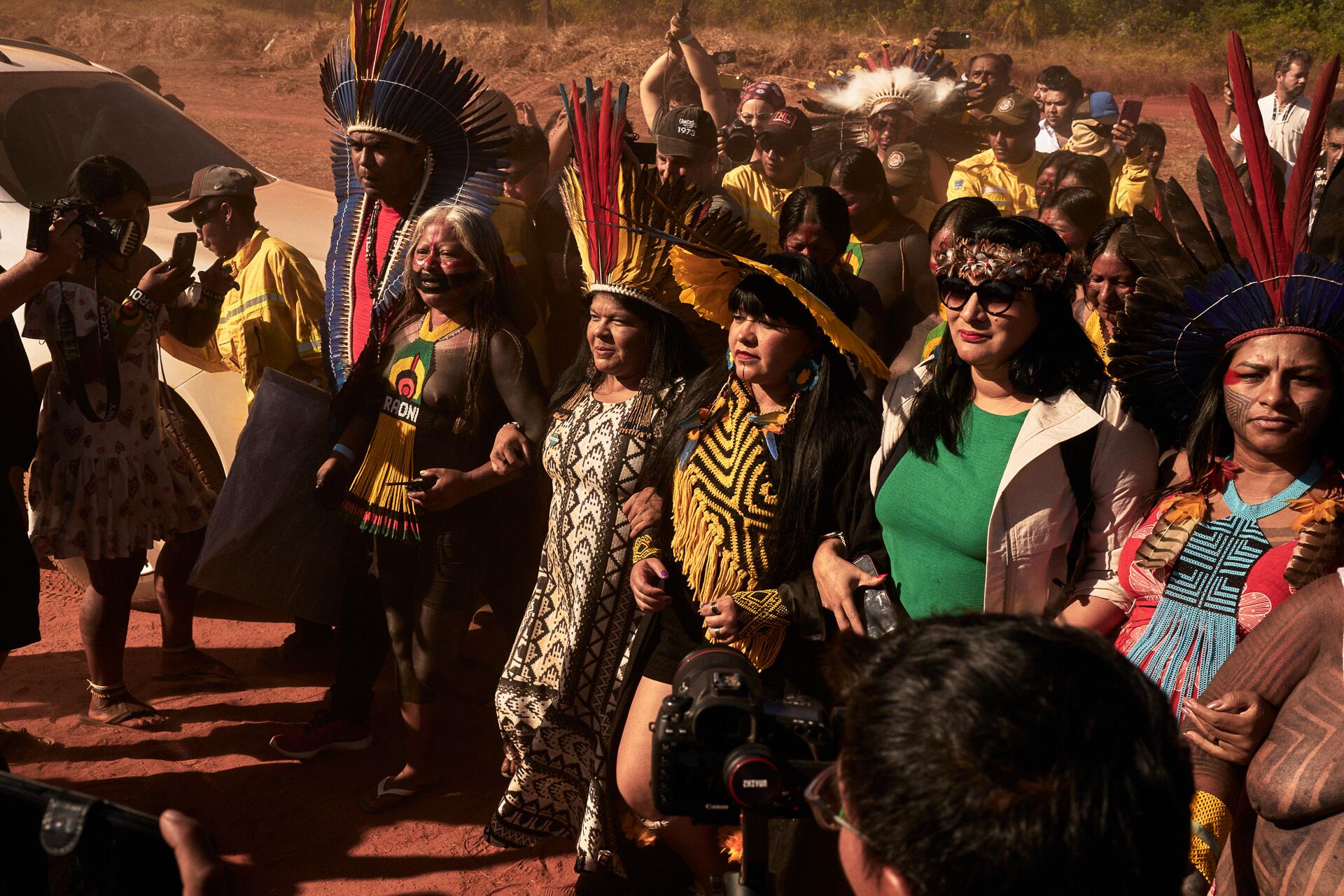
A delegation of Indigenous leaders walks together after disembarking from a Brazilian Air Force plane
‘This hot weather, this strong wind’
Sinop has the closest airport to Piaraçu Village offering regular flights. The city in Mato Grosso, founded just forty-eight years ago, is home to nearly 200,000 people and has become a flourishing “El Dorado of soy” – in 2022, it had the state’s highest Gross Domestic Product. It boasts bars and upscale restaurants, ads for luxury products and the shops that sell them, large new homes, and a profusion of gated condominiums. One of them, under construction, advertises a private landing strip, where future residents can take off to go straight to their large landholdings and their lands gained through misappropriation.
Small aircraft can carry you from Sinop to Piaraçu Village. Yet the easiest route – during the summer, the dry season in the Amazon – and the cheapest on is over land. The journey is 476 kilometers long and uses two highways, the BR-163 and the MT-322, filled with giant agribusiness trucks carrying soybeans to the ports of Miritituba and Santarém, in Pará. One stretch of the route, along the MT-322, is unpaved. However, dozens of pieces of heavy machinery and trucks are working to pave it right up to the point where it reaches Indigenous territory. This project, the darling of farmers and land-grabbers in the region, is part of a promise made by Mato Grosso’s governor, Mauro Mendes, and is a dream for Sandro José Luz Costa, the mayor of São José do Xingu. Both are affiliated with the Brazil Union party, created when the Democrats party – formerly the Liberal Front Party, a stronghold of supporters of the business-military dictatorship (1964-1985) – merged with the Social Liberal Party, Jair Bolsonaro’s party when he was elected president in 2018.
On hot dry days, bulk carrier trucks kick up massive clouds of fine dust. “I know why this hot weather, this strong wind is coming,” Raoni says. “I’ve been with the ones who these winds, this sun belongs to. Today, maybe they have an notion, feeling this hot sun on their skin, maybe this is how they learn. If we don’t care for the territory, all of this will end, and it won’t just end for us,” he said.
Capoto/Jarina leaders declined to pave their road. They prefer the dust. Raoni lives in Metuktire Village, north of Piaraçu, along the banks of the Xingu, reachable only by a forty-minute boat ride. Yet Piaraçu is strategic to the Kayapó in the region because of its easy access – in addition to the road, there is a landing strip for planes, like the twin-engine aircraft that flew in from Brasília to bring authorities to the event. It is also symbolic of the Kayapó’s struggle.
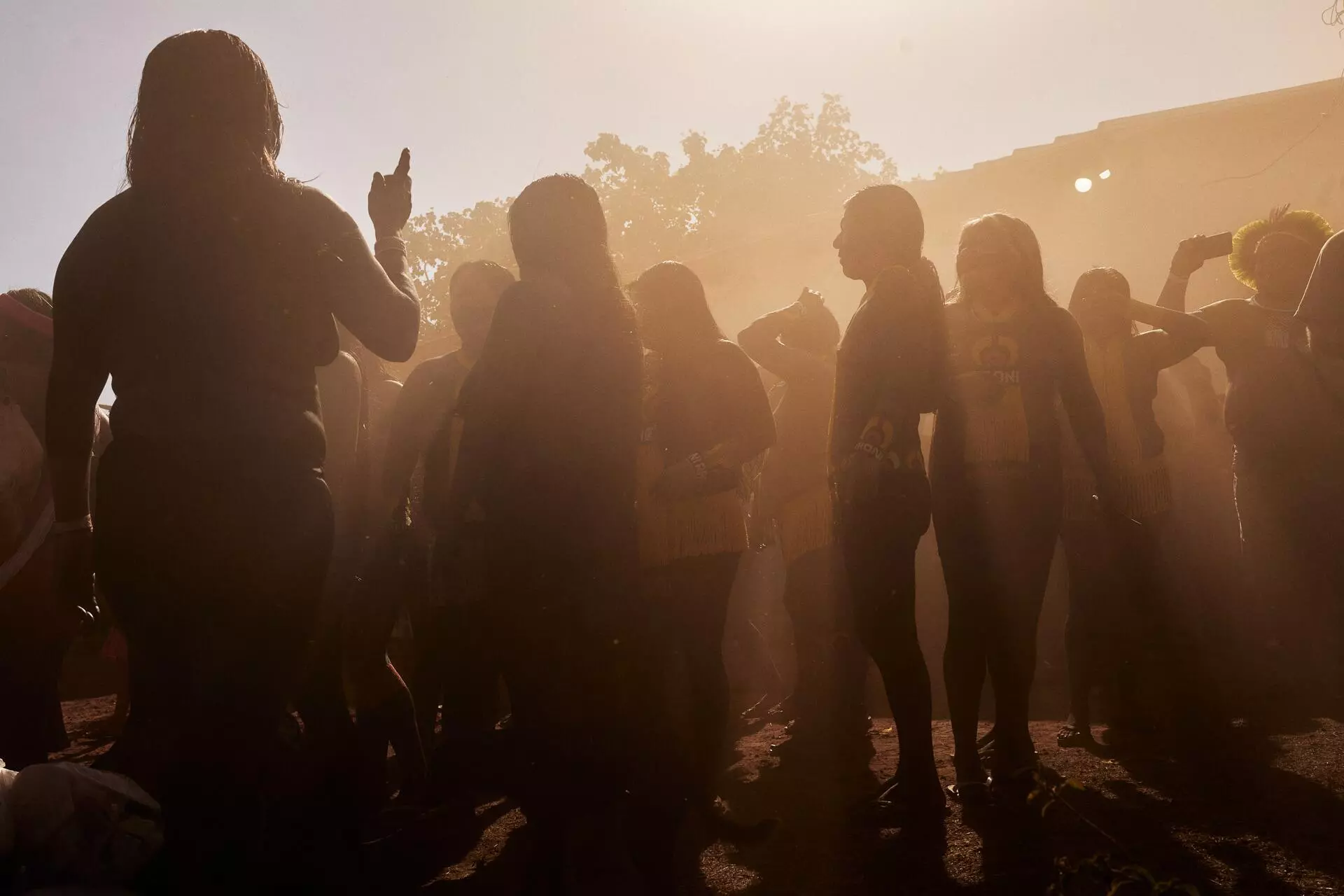
A delegation of Indigenous leaders reaches Piaraçu Village, for Raoni’s Call
Along the stretch that goes through Piaraçu Village, the MT-322 highway currently marks the border between the Xingu Indigenous Territory (formerly the Xingu Indigenous Park) to the south and the Capoto/Jarina Indigenous Territory to the north. When the highway was opened in 1971, it invaded Kayapó territory and the park, an area that had been demarcated in 1961 after intense pressure from brothers and explorers Cláudio (1916-1998) and Orlando Villas-Bôas (1914-2002). A story published in Folha de S.Paulo in the 1980s serves as a record of Raoni’s indignation with the project, which was delivered by Mário Andreazza, who at that time served as the minister of transportation under the dictatorship and who invited a delegation of twenty-three aircraft to a party inaugurating the highway, where a cook-out was held for “major executives who are starting to invest in the Amazon.”
Demarcating the territories of his people to the north became an obsession for Raoni. In February 1984, he traveled to Brasília, warning that if territories north of the road were not demarcated by April, he would act. When nothing was done, he made good on his promise. He and his nephew, Megaron Txucarramãe, took the ferry and held FUNAI and federal government workers hostage. The case made headlines at the time and ended up being called “the ferry war.” Forty days later, the Indigenous people were victorious. The dictatorship capitulated and agreed to begin demarcation.
Yet it was not a complete win. Kapôt Nhinore, the land where Raoni was born, was left out of the demarcated area. Nearly forty years later, the impasse persists. The progress in the demarcation that Joenia Wapichana announced is the first in eight years of a bureaucratic process that started at the FUNAI in 2004. Nature and the Indigenous people have paid dearly for this time: there are 201 farms and misappropriated areas covering a large portion of Kapôt Nhinore’s 362,000 hectares. Speaking to Canal Rural, an agribusiness news portal, Nilson Leitão (a politician affiliated with the Social Democratic Party who served as a federal deputy and as the mayor of Sinop and who is currently the head of Instituto Pensar Agro, an organization articulating pressure from large landholders on nature) accused Brazil’s federal Indigenous affairs agency of “immobilizing development” in the region. “There’s going to be a revolt in the farm industry, enormous action from the political class, which is going to be incapable of accepting an order like this that takes jobs and homes away from 201 property owners,” he promised days after Raoni’s event in Piaraçu.
The ruralist bloc’s information comes from FUNAI, but the official data show a different situation than what Leitão describes. There are actually 153 property owners, thirty-two rural squatters, and fifteen areas with no information in the Kapôt Nhinore territory. The list of “properties” supposedly totals 500,000 hectares, while Indigenous territory covers just 362,000 hectors, clearly indicating that land deeds are overlapping and that there are significant signs of land misappropriations.
The “development” that Nilson Leitão is arguing for sounds like death to Raoni’s people. “I have been saying this for a long time, defend the peoples, the forest, the animals, so that we have food. We are feeling the effects of the climate, which is changing, we are feeling lots of heat,” the elder warned during the event in Piaraçu. “That is why I ask: all of the Xingu must be together. Do not allow white people into our territory.”
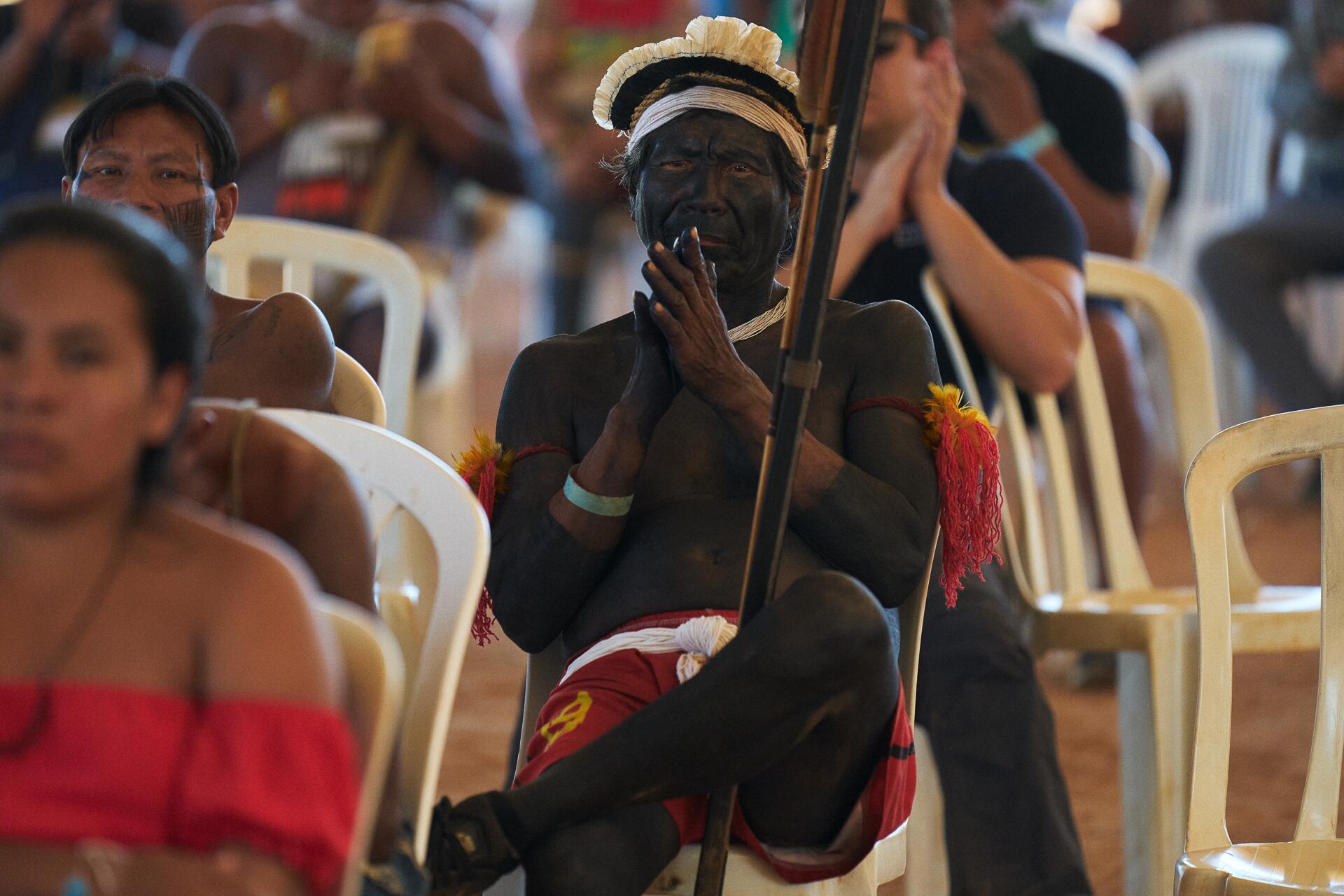
Representatives of Indigenous peoples from across Brazil went to hear cacique Raoni speak in his village
A message from Davi Kopenawa
Inspired by Raoni’s fight, shaman Davi Kopenawa made his own call in defense of the Yanomami people. “If you don’t resolve this, we’re going to prepare for war,” he warned. Kopenawa took advantage of attendance by Sonia Guajajara, Joenia Wapichana, and Weibe Tapeba at the event to send messages to the federal government.
The Yanomami’s strongest leader is annoyed with the delay in resolving the crisis caused by criminal mining on his peoples’ Indigenous land, driven by the extreme right-wing government of Jair Bolsonaro.
Not only does he demand a presence by Lula and his cabinet in critical areas in the territory, but Kopenawa also says that illegal mining is still strong and active. “It’s no use to just go there and take a picture. We’re dying of illnesses from illegal mining,” he reported. “I’m asking for the removal of illegal miners. Because the authorities promised and they can keep their promise. Or else we’re going to take up bow and arrow to make war with the white man who is stealing and destroying our lands, our waters.”
In a statement sent to SUMAÚMA, the Ministry of Indigenous Peoples alleged that “over the last few months, an inter-ministerial articulation has worked in cooperation with the Armed Forces, federal agencies, and public safety agencies to combat the lack of assistance provided to the Yanomami people and to remove intruders from their territory.” Despite recognizing that there are structural challenges to expelling the invaders and to dealing with malnutrition and malaria, the federal government’s task force argues that there has been a “95% reduction in the presence of illegal miners in the territory” and “119 arrests have been made of people involved with illegal mining in Yanomami Territory since February, with ninety-one of them occurring after June, when the decree that expanded military participation in battling illegal mining took effect.”
The trauma left by the Accelerated Growth Program
In an over forty-minute speech, Sonia Guajajara took stock of her management at the head of the Ministry of Indigenous Peoples. And she aired her grievances: “We’re terrified when we hear about the Accelerated Growth Program. Because we remember the major infrastructure works that impacted us.” She is referring to a program that would be relaunched under Lula two days later.
The 2023 version of the Program was given the slogan “Development and Sustainability.” The government promises that health and education projects will be the priority. However, it is worth remembering that the first incarnation of the Accelerated Growth Program sifted through a file of projects abandoned by the business-military dictatorship to revive the Kararaô – later renamed Belo Monte – hydroelectric dam project. “If there are going to be infrastructure works, they’ll have to be works that bring structure to Indigenous territories,” Sonia Guajajara demanded.
“Don’t think it’s easy for us to be in this place without managing to do the things we would like to do. The challenges are huge, because of the correlation of forces, which is still very unequal, and the bureaucracy of a government that is never prepared to serve the diversity of peoples that there are in this Brazil,” said the minister, who is in the uncomfortable position of simultaneously representing the government and Indigenous leaders, in a country that is far from finalizing the demarcation of the original peoples’ territories, as stipulated by the 1988 Constitution.
The previous afternoon, in a long talk with SUMAÚMA, Joenia Wapichana, FUNAI’s president, summed up the challenge. “We’ve reached an important space. Yet there must also be conditions so that these spaces are not just window dressing,” she mulled. “I want things to progress. There has to be the job, but there needs to be a structure to work.”
Lula’s very present absence
In April, in Brasília, Raoni extended a personal invitation to the president to attend the event. He promised to attend – and then he didn’t go. The embarrassment of explaining his absence fell to Minister Sonia Guajajara: “President Lula wanted very much to come. But unfortunately, he was advised by his doctors not to travel and he may need to undergo emergency surgery. He had me bring this message, that he will arrange another opportunity to meet Cacique Raoni.”
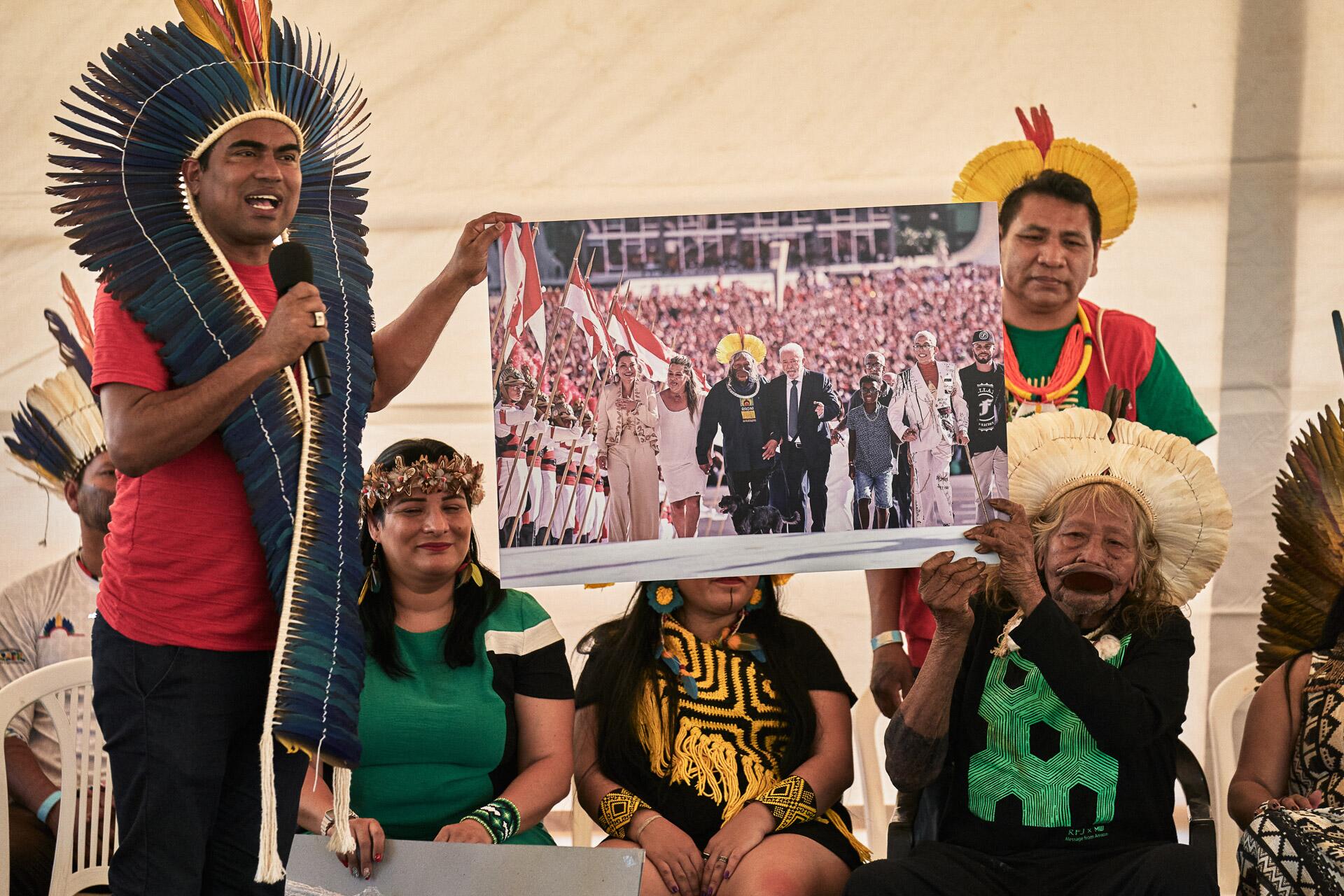
Indigenous Health Secretary Weibe Tapeba shows a photograph of Raoni walking up the ramp to the presidential palace alongside Lula, at his inauguration, in January 2023. Lula was expected at Raoni’s Call, but did not attend
That same afternoon, Lula was a groomsman at the wedding of Senator Randolfe Rodrigues (no party affiliation, representing Amapá), in Brasília. Two days earlier, the president had undergone a procedure to relieve hip pain, caused by arthrosis, to prepare for a future surgery. Lula smiled while he posed for pictures with the bride and groom and their guests. Randolfe Rodrigues, a government leader in Congress, was one of the first to attack the minister of Environment and Climate Change, Marina Silva, when Brazil’s environmental protection agency, IBAMA, denied Petrobras a license to drill an exploratory oil well in the Foz do Amazonas basin.
Lula was questioned on social media about why he chose to attend Randolfe’s wedding instead of Raoni’s event. When it became clear that the president would not attend, the Indigenous people released a letter that recalled Lula’s inauguration, on January 1, when he walked up the ramp to the presidential palace alongside the Indigenous elder and other minority representatives, creating a symbolic image to convey that Brazil had left behind the years of Fascism under Jair Bolsonaro: “Cacique Raoni already answered your call. And you all, when will you answer ours?”
There was no answer.
Lula’s absence was underscored by the presence of Herman Benjamin, a federal Appeals Court justice, the second highest court in the land, and of Melanie Hopkins, the deputy head of mission at the United Kingdom’s embassy in Brazil, who delivered a letter from King Charles III, Great Britain’s head of state, to Raoni.
Searching for the president’s ear
Days later, Raoni traveled to Belém to take part in the Amazon Summit, which brought together social movements and the leaders of eight rainforest countries. In Pará’s capital, the cacique waited for a chance to speak with Lula and finally hand him a letter asking for the demarcation of the Kayapó territory located between the Capoto/Jarina and Kapôt Nhinore Indigenous Territories.
Frustrations were compounded in Belém. Raoni expected an audience with the president, but was not received. He did manage to talk with members of his cabinet – Sonia, Marina and Nísia Trindade (Health), as well as Márcio Macêdo (head of the President’s General Secretarial Office). Annoyed, the cacique said that he will have to “give Lula an earful” the next time they meet.
When it’s Raoni making the promise, it might not be a manner of speaking. There is precedent. In 1984, after winning the “ferry war,” Raoni went to Brasília to speak with Mário Andreazza, at that time the Interior minister and one of the dictatorship’s most powerful men, commanding projects like the Trans-Amazonian Highway. Upon being welcomed to the Esplanade of Ministries, Raoni grabbed Andreazza’s ears and, pulling them, said: “I agree to be your friend, but you must listen to the Indian.” If he did this during the dictatorship, he’s likely to do it again. That is, if he manages to meet with Lula.
Spell check (Portuguese): Elvira Gago
Translation into Spanish: Meritxell Almarza
English translation: Sarah J. Johnson
Photography editing: Lela Beltrão
Page setup: Érica Saboya
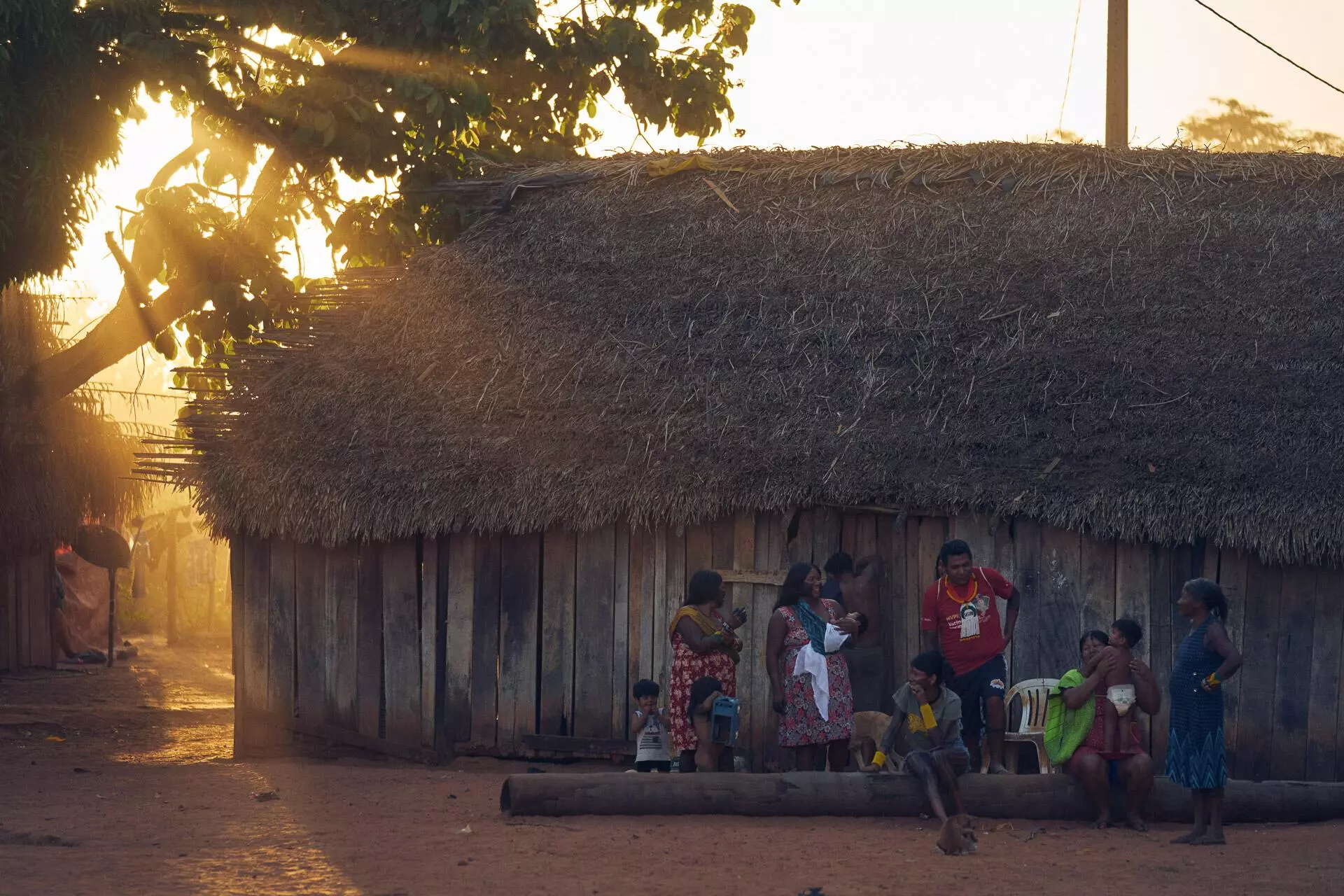
Village families listen to Raoni’s wise and impressive words during the event, which lasted five days





